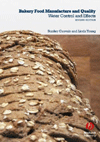One Child, One Child Too Many
It was the delegation's first official meeting with government officials and members of the World Cocoa Foundation's Ghana Cocoa Tour were advised to dress up. For men, that meant a jacket and tie, somewhat disconcerting given that following the meeting, lunch would be served outside. In Ghana , outside translates into heat and humidity.No matter, everyone looked quite presentable as I scanned the meeting room Sunday, May 27 at the Labadi Beach Hotel.
It was then that I noticed a youngster sitting next to one of the Ghanaian representatives scheduled to give a presentation.
I guess he's tagging along with his mother this Sunday morning, I thought. I sympathized with the young lad; nothing worse than having to listen to adults speaking in an enclosed room while one could be playing ball on the beach on a beautiful Sunday morning.
Well, there was more to sympathize about the boy's situation than a bit of boredom. His name is Kuami Richmond. Two years ago, his father's uncle paid him a visit in the village of Bauka , which sits in the upper East region of Ghana . Neither of his parents where with him when the relative stopped by, explained Sylvia Hinson-Ekong, managing director of Future Resource Development Ltd, a consulting group involved in working with Ghana's government to combat the worse cases of child labor and child abuse.
Asked by the great uncle to walk him to the bus station, Richmond did so. It was the beginning of a two-year nightmare that he's only now beginning to wake up from.
When Richmond was asked to get on the bus with the great uncle, he probably didn't understand the request, simply trusting in an elder. Even when his great uncle left the bus with his uncle still sitting next to him, Richmond may have not understood what was happening. After all, family trust is implicit in children.
When the bus departed in the dark of night, they traveled a long way, Richmond told Hinson-Ekong, who then translated the experience for me, as well as for Susan D'Arcy, Mars Inc. and Susan Smith, NCA, who asked to join in the interview.
Richmond wound up in the western region of Ghana in the cocoa growing community known as Jaebesa Manhy, Hinson-Ekong continued. There, Yakubu, Richmond 's uncle. promised him he would be going to school soon. In the interim, he helped on the farm, harvesting palm fruit and cocoa pods.
After a period of time, Yakubu took the boy to more remote region and left him with a woman, who also put him to work, picking the prickly palm fruit, carrying it back to the farm and then pounding it to a pulp before it's cooked. Naturally, there was also weeding and just general farm work.
Before long, Richmond was transferred again, this time to work for a man known as Kwadwo “Kojo” Adai. Again, the same kind of work involving palm and cocoa. When D'Arcy asked Hinson-Ekong whether the boy had suffered any physical harm, Richmond responded by saying he still had neck and back pains from carrying heavy loads.
He then showed us the scars on his leg, which came from errant strokes of the weeding blade he was using.
Richmond 's rescue came when the government's outreach program, which involved trained individuals going out to the farming communities to take measure of local practices, reached the area where Richmond was staying.
In talking to locals as well as children, it became apparent that the young boy wasn't there of his own volition. Word got back to Hinson-Ekong, who temporarily took him in until social services could finish the legal process of returning him home to his parents.
Hinson-Ekong told us that she had dealt with three more such cases so far, each having similar scenarios.
In truth, Richmond 's story reveals the reality of child labor – that even in a country like Ghana , where government, non-profit organizations, multinational chocolate manufacturers and individuals have doubled their efforts in educating the populace – abuses do occur.
More importantly, these abuses don't disappear without intense involvement.
As Isaac Osei, chief executive of the Ghana Cocoa Board, pointed out to the delegates during the meeting, “We're all on the same side, we all want to eliminate the worst forms of child labor. And while child labor abuses are not widely prevelant in Ghana , even a single child being abused is too much. These are our children and we ought to do something about it.”
Osei pointed out that the legal framework is in place, and that the government has redoubled its efforts to ensure that “not a single child suffers.”
As I mentioned earlier in my May editorial, Ghanaian government recent survey on child labor abuses quantifies Richmond 's story. It also adds a sense of urgency to eradicating the problem.
But as Akosua Frema Osei-Opare,deputy minister of the Ministry of Manpower, Youth and Employment who heads up the National Program for the Elimination of the Worst Forms of Child Labor said, “It's not enough to identify a problem, it's what do you do about it.”
In a way, Richmond typifies how the remediation process works - one child at a time.



